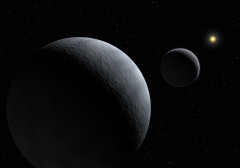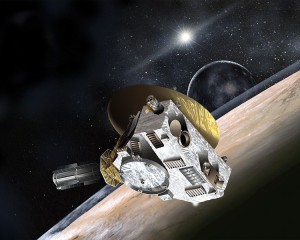
Thirty-seven days from now, on 14 July, NASA’s New Horizons spacecraft will sweep past the dwarf planet Pluto, its large companion Charon, and a system of at least four tiny moons, as it reaches the climax of a 9.5-year voyage to unveil a group of the Solar System’s farthest known celestial bodies. In doing so, as described in yesterday’s AmericaSpace article, it will bring full-circle our first-time exploration of each of the traditionally accepted nine planets in the Sun’s realm. Although Pluto was demoted back in 2006 to the status of a dwarf planet, a trans-Neptunian object, and the largest known body in the Kuiper Belt, and has proven the butt of much cruel humor, fierce debate still exists on whether it should be reinstated as a fully fledged “planet” or if it should retain its somewhat less lofty descriptor. Over the coming days and weeks, AmericaSpace’s New Horizons Tracker and a series of articles by Mike Killian, Leonidas Papadopoulos, and myself will cover the discovery and exploration of Pluto to date, the many trials and troubles faced by those who desired to send a spacecraft there, and the unfolding developments as New Horizons seeks to make this unknown world known.
Following confirmation of the new world’s discovery on 13 March 1930, the news spread across the world. Reading of the discovery in The Times on 14 March, whilst sat at breakfast table in a well-to-do dining room in Oxford, England, was retired Bodleian librarian Falconer Madan and his 11-year-old granddaughter, Venetia Burney. The young girl had been learning about classical mythology at school and suggested to her grandfather that the new world should be named “Pluto,” after the ancient Roman god of the underworld. “I was quite interested in Greek and Roman myths and legends at the time,” she explained in a January 2006 interview for the BBC, adding that astronomy also left an indelible mark on her. “At school, we used to play games … putting lumps of clay at the right distance from each other to represent the distances of the planets from the Sun. Some of the distances I can still more or less remember, so it was probably a good lesson to have had.”
Venerated by the ancients as a stern and violent ruler, Pluto’s original Classical Greek name was “Plouton” and today he is associated as the overlord of Hades, the chthonic land of the dead, to which the souls of the departed were ferried across the River Styx by the mysterious boatman, Charon. His name was subsequently Latinized to “Pluto” by the Romans, producing the current form of the name. He is perhaps best known as the husband of Persephone, whom he abducted from her mother, the goddess Demeter, and later forced to spend a third of each year with him in the dark, gloomy underworld, receiving the souls of the dead and dispensing judgment upon them.

Lying so far from the Sun, in such a dark and gloomy region of the Solar System, to Venetia Burney, “Pluto” was thus the ideal name for the new world. Her grandfather was so impressed that he contacted his friend, Prof. Herbert Hall Turner, director of the University of Oxford’s observatory, who coincidentally happened to be at a meeting of the Royal Astronomical Society (RAS) in London, debating a name. “It was incredibly lucky in a number of ways,” Burney—who subsequently became a teacher of mathematics and economics, married, and became Venetia Phair—explained in later life. “Firstly, I was lucky in having a grandfather who pursued the matter and knew Prof. Turner. And it is extremely lucky that the name was there. There were practically no names left from classical mythology. Whether I thought about the dark and gloomy Hades, I’m not sure.”
For his part, Falconer Madan dropped a note off at Prof. Turner’s house during one of his regular visits to the Bodleian Library. In Turner’s mind, all of the names considered to date—which included Minerva, Zeus, Atlas, and Persephone—seemed unsuitable for the new world, with “Cronus” briefly considered a possibility, but dismissed as it was actually the Greek equivalent of Saturn. “I think Pluto is excellent,” Turner later wrote to Falconer Madan. “We did not manage to think of anything so good at the RAS.” He sent a telegram to his colleagues at the Lowell Observatory. “Naming new planet,” he advised them, “please consider Pluto, suggested by small girl Venetia Burney for dark and gloomy planet.” It was saddeningly fortuitous that Turner wrote when he did, for he passed away suddenly from a haemorrhage in August 1930.
On 1 May 1930, it was official and the new planet was named Pluto, decisively beating the other two finalists, Cronus and Minerva. Although it was generally well received, there were several individuals who disliked it, particularly Charles Freedom, superintendent of the U.S. Naval Observatory in Washington, D.C., who regarded it as “the prototype of Satan in many minds.” Others paid tribute to the fact that the name’s first two letters honored Percival Lowell, the man who had come so close to find the planet in his exhaustive searches. Even Lowell’s friend, William Pickering, was fond of the name, joking that its first two letters offered a nod to his own and Lowell’s calculations, as “Pickering-Lowell.” For her part, Venetia Burney received a substantial reward of £5 from her grandfather—“he liked to have an excuse for generosity”—and passed blissfully into obscurity, re-emerging periodically into the limelight whenever “her” planet made the news.
Invited by NASA in January 2006 to attend New Horizons’ launch from Cape Canaveral Air Force Station, Fla., she was forced to decline, on account of her advancing age. However, in June of that year, NASA announced that it had named New Horizons’ student-built dust counter as “Venetia.” “I feel quite astonished, and to have an instrument named after me is an honor,” the 87-year-old retired teacher commented at the time. “I never dreamed when I was 11 that, after all these years, people would still be thinking about this and even sending a probe to Pluto. It’s remarkable.” In making the announcement, Dr. Alan Stern, New Horizons’ Principal Investigator, commented that it was “fitting” that one of the spacecraft’s should honor “her historic, early role in the saga of the ninth planet.” She died in 2009.

In the decades after Pluto’s discovery, significant reassessments were made about the new world, as its estimated size and mass continued to progress in a downward direction. At first, it was suspected to be about the same equatorial diameter as Earth, but 1949 observations by Gerard Kuiper, using the 200-inch (510-cm) telescope at Mount Palomar Observatory, operated by the California Institute of Technology in San Diego County, Calif., led him to the conclusion that it was sized midway between Mercury and Mars, with a mass about a tenth of Earth. However, even with such large astronomical instruments, it was difficult until as late as the 1970s to discern any significant detail about Pluto, other than a rotation rate of about 6.4 Earth-days and a handful of details about the nature of its highly elliptical orbit.
That situation began to change in 1976, when frozen methane was spectroscopically detected on the planet’s surface by Dale Cruikshank, Carl Pilcher, and David Morrison of the University of Hawaii at Honolulu. Their work marked the first occasion that anything other than water ice or frozen carbon dioxide had been discovered spectroscopically, anywhere in the Solar System, and the presence of frozen methane implied that Pluto’s surface must be highly reflective. Following this line of discussion further, the measured brightness and its known distance from Earth and the Sun suggested that Pluto must be about 0.01 Earth-masses, far smaller than previously supposed and smaller even than our Moon. Similar conclusions had earlier been reached by Dennis Rawlins, who measured albedo variations between Pluto and Neptune’s large moon, Triton, and suggested that both bodies were of similar mass.
Two years later, in June 1978, U.S. Naval Observatory astronomer James Christy was in the process of examining an enlarged photographic plate of Pluto from April 1965, in tandem with more recent images from the 61-inch (1.5-meter) telescope at U.S. Naval Observatory Flagstaff Station (NOFS). He spotted a noticeable “bulge” apparently emanating from one side of the planet’s disk. At first, it was supposed that the anomaly represented a default in the image, caused by improper alignment, and this suspicion endured for more than a decade. However, upon closer examination, Christy noticed that only Pluto itself appeared elongated in the image and he concluded the presence of a large attendant moon.
It remained possible, of course, that the distortion might be due to Pluto having an irregular shape, but subsequent mutual eclipses of the two bodies on five occasions between 1985-1990 confirmed the existence of the moon, which was named “Charon,” after the boatman who ferried the souls of the dead across the River Styx to Hades. Despite being originally pronounced in Latin in a similar fashion to “Karen,” the name also proved helpful to Christy himself, whose wife, Charlene, was nicknamed “Char.” Yet the name was perfectly in harmony with Pluto itself. In ancient times, a coin—known as “Charon’s obol”—was traditionally placed onto the tongue of a dead person, in order to pay the boatman for his service in conveying the soul across to Hades and into Pluto’s realm.

In the years after Charon’s discovery, estimates were made by Robert Harrington of its orbit and the mass of Pluto itself; in effect, the moon had provided a significant breakthrough in our understanding of the ninth planet. The result confirmed that Pluto is about a fifth as massive as our Moon, thus nowhere near sufficient to have perturbed Uranus’ or Neptune’s orbits. Moreover, its relationship with Charon was less of a host-satellite one, and more of a “binary-planet.” Charon orbits about 11,700 miles (18,800 km) from Pluto’s surface, circling every 6.4 Earth-days, exactly matching the rotation rate of its larger partner. In the same manner as our Moon, Charon keeps the same face directed toward Pluto in perpetuity. However, unlike our planet, which spins 29.5 times for each lunar cycle, one side of Pluto always faces Charon and vice versa. An observer on Pluto’s Charon-facing side would see the moon hanging in the sky, unchanging its position over the years, whilst an observer on the planet’s space-facing side would not even know that his world possessed a moon.
Surprisingly, Charon’s north-south motion—indicative of the fact that the pole of its orbit resides within the plane of the ecliptic—provided clear evidence that Pluto’s own rotational axis was tipped very closely to the ecliptic, in a similar fashion to Uranus. It soon became apparent that Charon’s orbital plane would be seen edge-on from Earth in the mid-1980s and proved extremely fortunate in terms of timing, for these mutual eclipses occur only twice in Pluto’s 248-Earth-year orbit of the Sun. “We immediately appreciated our good fortune,” explained Cruikshank in a chapter on Pluto, Triton and Charon for the fourth edition of The New Solar System. “Had Charon been discovered in, say, 1993, we would had to wait until the 22nd century to witness the next series of overlappings.” The alignments enabled astronomers to spectroscopically monitor the faint emissions from the system, revealing an approximate diameter for Pluto about two-thirds the size of our Moon.
The combined density of the two worlds suggested a composition of 60-70 percent rocky materials, with 30-40 percent ices. Moreover, the rotational locking of the two worlds was suggestive of Charon being a large body, relative to its host, and celestial dynamicists have suggested that the size ratio between the two is closer than any other host-satellite pairing in the Solar System. Present estimates show Charon to be a little more than half the size of its host, with an equatorial diameter of about 750 miles (1,200 km), compared to Pluto’s 1,470 miles (2,370 km). Spectroscopy has also revealed Pluto to be predominantly coated with ices of nitrogen and methane. This can be compared to less volatile water ices in the case of Charon, with patches of ammonia hydrates and water crystals detected in 2007, suggesting the possible presence of active cryovolcanism or cryogeysers, perhaps not dissimilar to those observed on Neptune’s moon, Triton. Current thinking suggests that Charon’s overwhelmingly icy composition may indicate that it was formed as a consequence of a giant impact into Pluto’s icy mantle.
As will be explored in next weekend’s series of Pluto and New Horizons articles, Hubble Space Telescope (HST) and advanced ground-based imagery over the past two decades has revealed significant inroads into our understanding of this strange system and, until mid-May 2015, these observations were the most comprehensive in our possession. As New Horizons draws closer to its date with destiny on 14 July, many of the questions surrounding both Pluto and Charon—and four other, smaller moons, named Nix, Kerboros, Hydra, and Styx, discovered between 2005-2012—will hopefully be resolved, as well as undoubtedly inspiring new questions.
This series will continue next weekend, as AmericaSpace explores humanity’s advancing knowledge of Pluto with the dawn of the Space Age and the development of new imaging and spectroscopic technologies on Earth.
Want to keep up-to-date with all things space? Be sure to “Like” AmericaSpace on Facebook and follow us on Twitter: @AmericaSpace
Missions » New Horizons »



The July fly-by will generate incalculable science, matching the Mars rovers and other planetary spacecraft with their amazing discoveries and photos. Imagine “orbiters” and “landers” to the Pluto system as well as to the Jupiter/Saturn moons. How we have extended mankind’s reach in the cosmos….incredible!